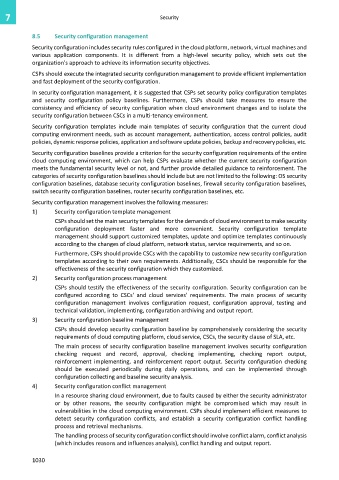Page 1038 - Cloud computing: From paradigm to operation
P. 1038
7 Security
8.5 Security configuration management
Security configuration includes security rules configured in the cloud platform, network, virtual machines and
various application components. It is different from a high-level security policy, which sets out the
organization's approach to achieve its information security objectives.
CSPs should execute the integrated security configuration management to provide efficient implementation
and fast deployment of the security configuration.
In security configuration management, it is suggested that CSPs set security policy configuration templates
and security configuration policy baselines. Furthermore, CSPs should take measures to ensure the
consistency and efficiency of security configuration when cloud environment changes and to isolate the
security configuration between CSCs in a multi-tenancy environment.
Security configuration templates include main templates of security configuration that the current cloud
computing environment needs, such as account management, authentication, access control policies, audit
policies, dynamic response policies, application and software update policies, backup and recovery policies, etc.
Security configuration baselines provide a criterion for the security configuration requirements of the entire
cloud computing environment, which can help CSPs evaluate whether the current security configuration
meets the fundamental security level or not, and further provide detailed guidance to reinforcement. The
categories of security configuration baselines should include but are not limited to the following: OS security
configuration baselines, database security configuration baselines, firewall security configuration baselines,
switch security configuration baselines, router security configuration baselines, etc.
Security configuration management involves the following measures:
1) Security configuration template management
CSPs should set the main security templates for the demands of cloud environment to make security
configuration deployment faster and more convenient. Security configuration template
management should support customized templates, update and optimize templates continuously
according to the changes of cloud platform, network status, service requirements, and so on.
Furthermore, CSPs should provide CSCs with the capability to customize new security configuration
templates according to their own requirements. Additionally, CSCs should be responsible for the
effectiveness of the security configuration which they customized.
2) Security configuration process management
CSPs should testify the effectiveness of the security configuration. Security configuration can be
configured according to CSCs' and cloud services' requirements. The main process of security
configuration management involves configuration request, configuration approval, testing and
technical validation, implementing, configuration archiving and output report.
3) Security configuration baseline management
CSPs should develop security configuration baseline by comprehensively considering the security
requirements of cloud computing platform, cloud service, CSCs, the security clause of SLA, etc.
The main process of security configuration baseline management involves security configuration
checking request and record, approval, checking implementing, checking report output,
reinforcement implementing, and reinforcement report output. Security configuration checking
should be executed periodically during daily operations, and can be implemented through
configuration collecting and baseline security analysis.
4) Security configuration conflict management
In a resource sharing cloud environment, due to faults caused by either the security administrator
or by other reasons, the security configuration might be compromised which may result in
vulnerabilities in the cloud computing environment. CSPs should implement efficient measures to
detect security configuration conflicts, and establish a security configuration conflict handling
process and retrieval mechanisms.
The handling process of security configuration conflict should involve conflict alarm, conflict analysis
(which includes reasons and influences analysis), conflict handling and output report.
1030

